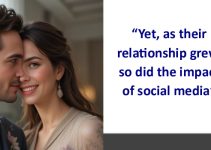



Prologue: The Feed
San Francisco’s skyline flickered with the glow of a million screens. Below, Elena Chen scrolled through her phone on the Muni train, her thumb pausing over a post from @WanderLiam—a sunrise photo tagged Big Sur, 5:32 a.m. She double-tapped it, as she had every morning for weeks. Across the city, Liam Hayes stared at his analytics, noting the anonymous user @EchoInTheStatic who liked his posts like clockwork. He didn’t know her name, but her loyalty felt like the closest thing to intimacy he’d had in months.
Elena’s Edge
Elena had always been a ghost in plain sight. At 28, she curated a life of quiet routines: coding by day, sketching by night, and swiping on Spark, a dating app that promised “deeper connections through AI.” Her profile was a masterclass in calculated vulnerability—a photo of her sipping matcha at Dolores Park, a quote about “loving solitude but hating loneliness.”
Then came Alex.
They matched after his AI-generated opener: “Your eyes have the chaos of a Google Maps reroute. Coffee?” Their first date was a disaster—he spent half of it filming a TikTok about “dating a techie.” But Elena returned his texts anyway, lulled by the dopamine drip of his attention. When he ghosted her after three weeks, she deleted the app… only to redownload it at 2 a.m., her thumb hovering over his still-active profile.
“You’re addicted to potential,” her roommate Priya warned. “These apps aren’t love—they’re slot machines.”
Liam’s Loop
Liam’s life was a performance. As a travel influencer, he sold authenticity to 250K followers while hiding his agoraphobia. His therapist called it “digital disassociation”; his manager called it “brand consistency.”
Every morning, he staged “candid” shots from his apartment balcony, editing out the homeless encampments below. At night, he DM’d fans who called him “brave” and “free,” their words glowing like fireflies in his darkened studio.
Then came the panic attack during a live stream.
“Sorry, guys—bad signal!” he laughed, freezing the video as his breath hitched. The comments flooded in: “UR A LEGEND LIAM!!” “GOALS AF.” No one noticed his trembling hands.
The Glitch
The Spark algorithm noticed Elena’s late-night scrolls. “We found someone who mirrors your soul,” its notification chirped.
His name was Mark. A graphic designer who quoted Octavia Butler and hated avocados. Their texts unfolded like a indie rom-com—witty banter, voice notes laughing over The Office, a shared playlist titled “Digital Love Letters.”
For two months, they existed in a bubble of blue light. When he asked to meet, Elena panicked. “What if we’re better online?” she typed, then deleted.
They chose a neutral zone: a bookstore café. Mark arrived 15 minutes late, his face half-hidden by a mask. “Sorry—allergies,” he mumbled. Their conversation stuttered like buffering video.
“You’re… quieter than I expected,” he said.
“You’re taller,” she replied.
That night, Mark unmatched her.
The Echo Chamber
Liam’s follower count plateaued. His manager pushed him to pivot: “Do a couples’ retreat collab! Romance sells.”
He partnered with @AdventureAva, a rock climber with a laugh like wind chimes. Their staged kisses in Joshua Tree went viral. Fans shipped #LiamAndAva; brands offered partnership deals.
But in their final DM, Ava wrote: “This was fun. Let’s never speak again.”
Liam stared at his phone, the blue light reflecting in his unwashed coffee mugs. He opened his “Close Friends” story—a curated list of 12 people he hadn’t seen IRL in years—and posted a sunset.
@EchoInTheStatic liked it within seconds.
The Unfollow
Elena’s sketches grew darker—faces fractured into pixels, hearts wrapped in USB cords. Priya staged an intervention: “You need to detox. Come to Jake’s cabin in Mendocino—no service, just trees.”
For three days, Elena journaled, hiked, and relearned silence. On the drive back, her phone buzzed with 82 notifications.
A message from Alex: “Miss u. Drinks?”
She blocked him, then opened Spark one last time. The AI bot prompted: “We’ve refined your matches! Meet…”
Elena deleted her account.
The Offline Mode
Liam’s agency dropped him after a drunken Instagram story rant. “You’re not relatable anymore,” his manager said.
He wandered the Mission District, snapping photos he’d never post. At a dive bar, he recognized a woman sketching in a corner—@EchoInTheStatic, though he didn’t know it yet.
“Can I sit here?” he asked.
Elena glanced up. “Only if you’re not filming.”
They talked until last call. No phones, no filters. When Liam mentioned his fear of airports, Elena showed him her sketchbook: “This is how I see the world—through cracks in the noise.”
The Human Update
One year later.
Elena’s art exhibit—“Analog Hearts in a Digital World”—featured a mural of tangled phone cords blooming into roses. Liam, now a street photographer, hung a print nearby: two shadows holding hands beneath the words “Connection Found Offline.”
They never dated. But every Thursday, they meet at the same bar, phones left in coat pockets.
Outside, the city keeps scrolling.
Family Systems
Amara’s mother stood in the doorway of Malik’s row house, her sari a crisp saffron against the chipped paint of the porch. She held a stainless steel tiffin carrier like a shield.
“Beta, I brought dal,” she said, her voice taut. “And your cousin Rohan sent more biodata proposals. One boy is a cardiologist in Houston—”
“Maa, not now,” Amara interrupted, stepping aside to let her in.
Malik emerged from the kitchen, wiping his hands on a dish towel. “Namaste, Aunty,” he said, folding his palms in a gesture he’d practiced for weeks.
Her mother’s nod was glacial. “You cook?”
“Trying to,” he said, gesturing to the curry simmering on the stove. “Amara’s teaching me.”
“Ah. My daughter never learned either,” she replied, unpacking tupperwares with deliberate clinks. “Too busy saving the world.”
Later, as they ate in strained silence, Amara’s phone buzzed—a notification about a Black teen shot by police in her district. Malik’s jaw tightened; he excused himself to take a call.
“His father,” her mother began, her tone a scalpel, “is he still…?”
“In prison? Yes,” Amara snapped. “For a bag of weed smaller than your purse. Twenty-two years, Maa. Does that satisfy your background check?”
Her mother’s eyes flashed. “You think I enjoy worrying? This country brands us all, Amara. You want to fight their systems? Start by protecting your own.”
When Malik returned, the air hummed with unsaid things.
The Incident
The footage was raw, shaky. Malik’s camera captured the officer’s knuckles whitening on his baton, the Black driver’s pleading “I was just reaching for my registration!” Amara’s voice pierced through—“He’s press, you’re on film!”—before the screen jolted skyward, a blur of asphalt and screams.
By dawn, the video had 500K views. The comments were a minefield:
@TruthWarrior23: “Brown girl cosplaying allyship. Cringe.”
@RealAmericaFirst: “Race-mixing = cultural suicide.”
@Tasha94: “Black men, protect your own! Stop letting outsiders fetishize our pain.”
Amara deleted her social apps, but the threats slithered into her texts: “Go back to curryland.” Malik’s inbox fared worse—photoshopped lynching memes, a fake obituary with his name.
“We need to hit back,” Malik said, pacing their living room. “Do a joint livestream. Expose the trolls.”
“And feed their drama?” Amara hugged her knees to her chest. “They want us performative. Broken.”
He knelt before her, his hands warm on her cold ankles. “Then what? Hide forever?”
“I just… I can’t breathe,” she whispered.
They slept in separate rooms that night.
Parallel Lives
Amara’s organizing work became a refuge. She curated workshops titled “Solidarity Beyond Hashtags,” her voice steady as she lectured: “Allyship isn’t a selfie. It’s showing up when the cameras leave.”
But at night, she scrolled Malik’s Instagram—a photo of him filming at a border detention camp, his locs tucked under a beanie, shadows pooling under his eyes. She hovered over the ❤️, then closed the app.
Malik, meanwhile, threw himself into editing his documentary. His hard drive filled with scenes of Amara he’d never admit to rewatching: her laughing at his failed roti attempts, her fiery speech at a city council meeting.
“You’re obsessed,” his sister teased during a rare FaceTime.
“Nah,” he lied. “Just… archiving.”
Redefining Home
The vigil was Amara’s idea. “We’ll light diyas in honor of Mr. Rahman,” she told the crowd, her hands trembling as she passed out tea lights. “Light against darkness. Community against hate.”
Malik filmed from the periphery, zooming in on a Black grandmother arm-in-arm with a Somali hijabi teen. When Amara began chanting “Shanti”—her voice cracking like dried earth—he lowered the camera.
Afterward, he found her behind the community center, her face streaked with kajal and tears.
“You were amazing,” he said.
“Was I?” She laughed bitterly. “Half the comments tomorrow will call me a ‘coconut’ or ‘terrorist sympathizer.’ There’s no winning.”
He cupped her face, his thumb brushing her cheek. “Since when do we play to win? We play to outlast.”
Their kiss tasted of salt and smoke.
New Maps
Five years later, Malik’s documentary premieres at a sold-out theater. The final scene shows Aaravi, their 3-year-old, toddling between altars they’ve built: one for Malik’s ancestors—a photo of his great-grandmother beside collard greens—and one for Amara’s, a statue of Ganesh amid marigolds.
In the Q&A, a young woman asks Amara: “How do you reconcile your cultures without diluting them?”
Amara glances at Malik, who bounces a sleepy Aaravi on his knee. “We stopped trying to reconcile,” she says. “We let them argue, sing, mourn, feast—same as any family. Love isn’t about harmony. It’s about making room for the noise.”
Afterward, they walk home through Philly’s snow-glazed streets. Aaravi babbles a mashup of Gujarati lullabies and Negro spirituals, her mittened hands clutching theirs.
“She’s our peace treaty,” Malik murmurs.
Amara squeezes his hand. “Nah. She’s our revolution.”



